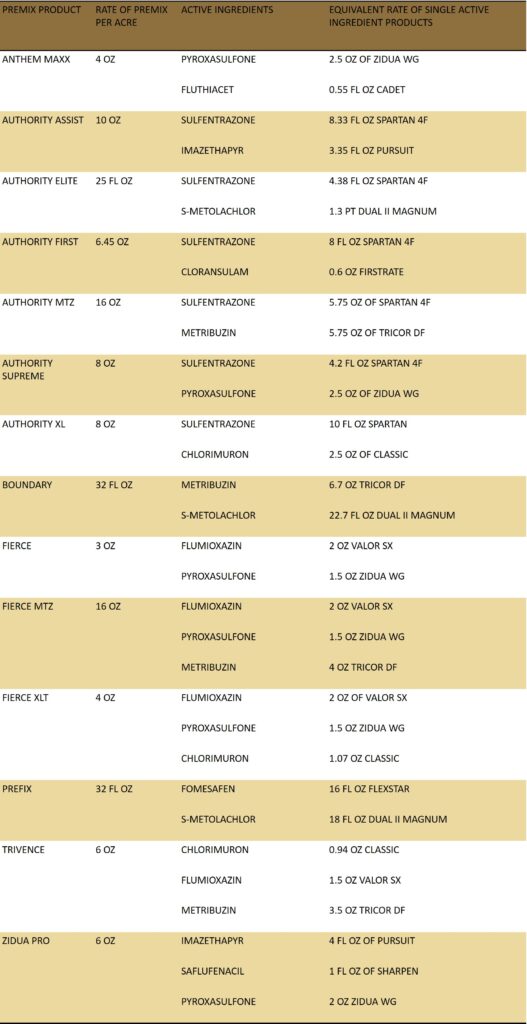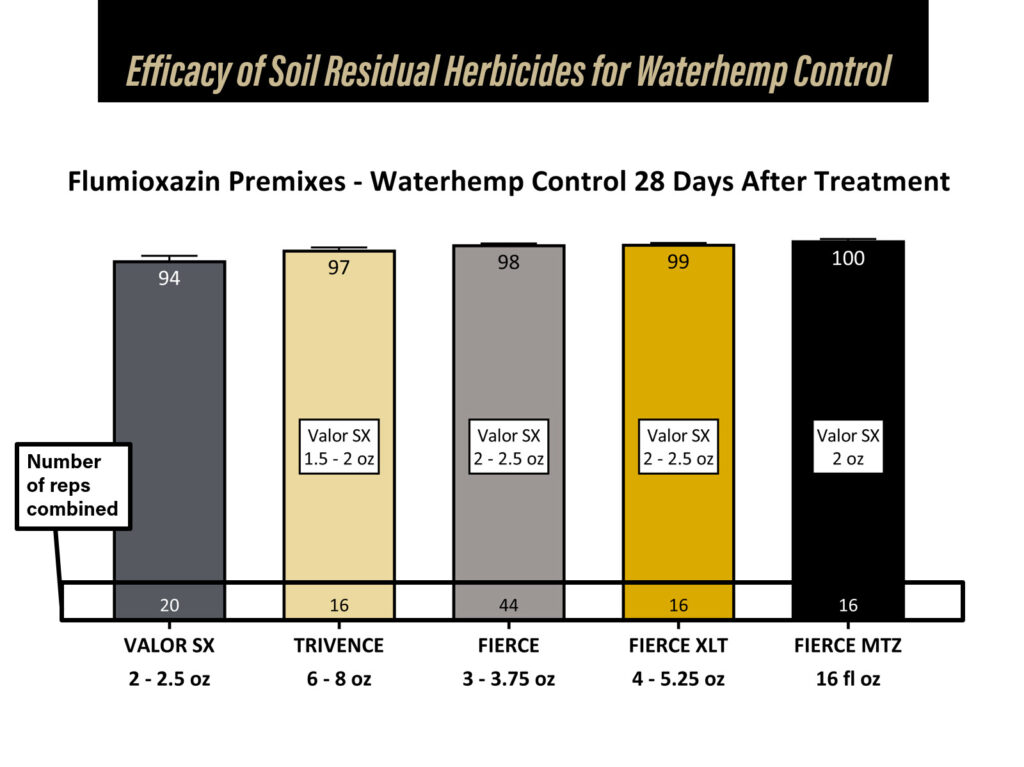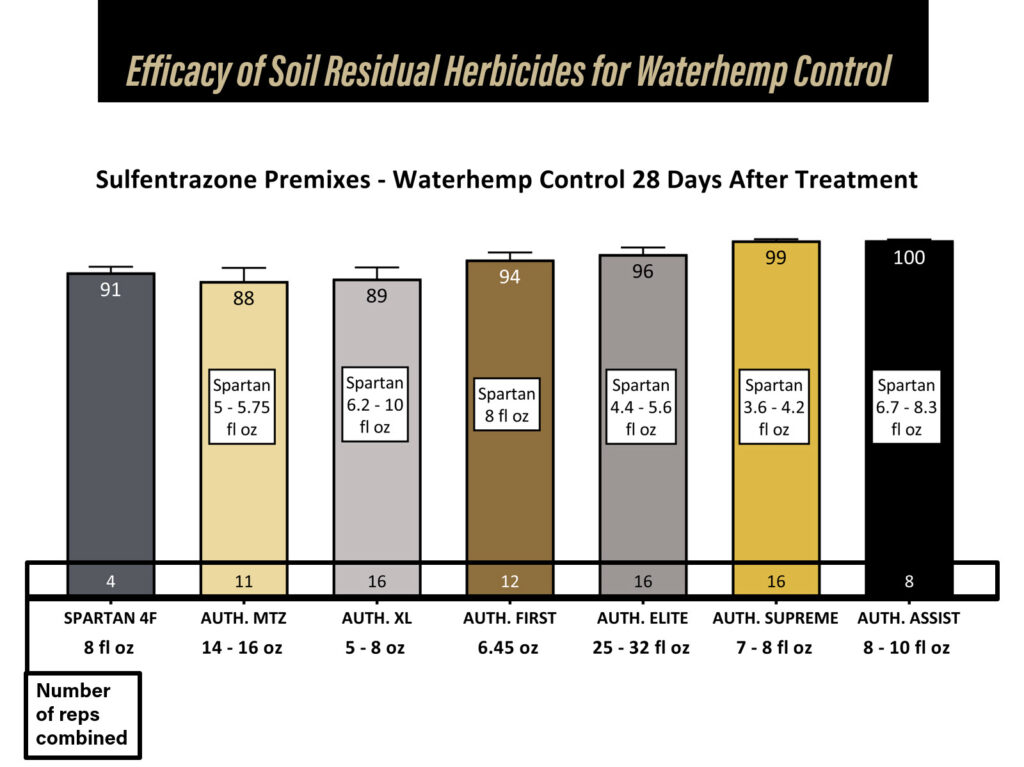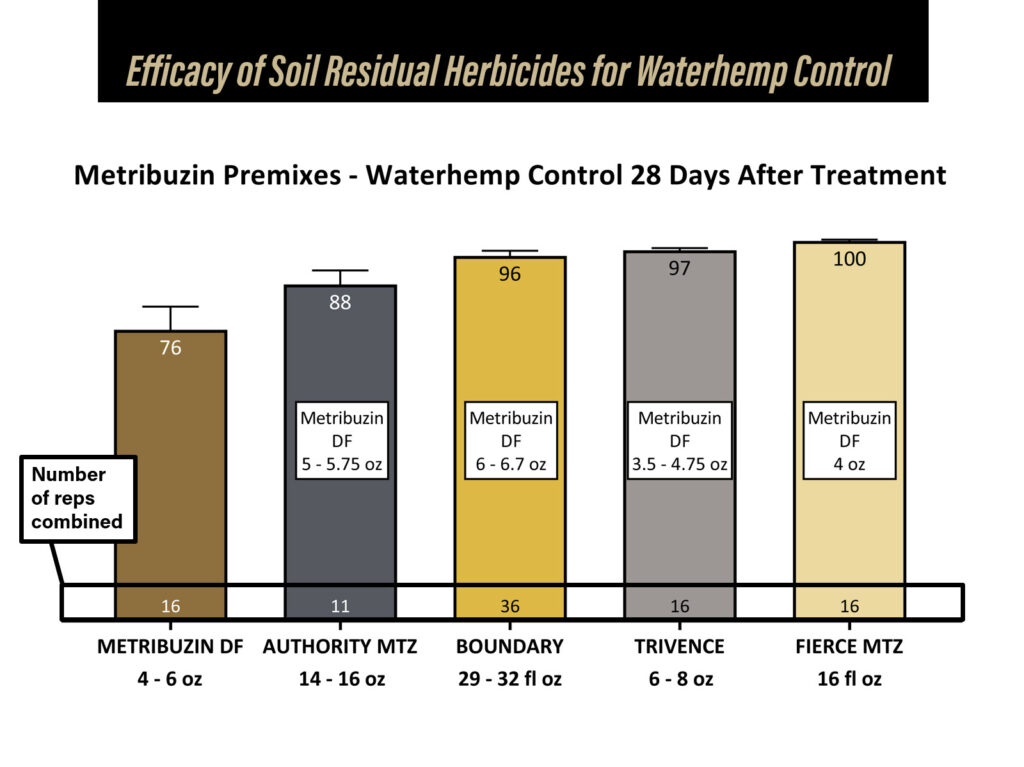Which Residual Herbicide Should I Use for Waterhemp Control in Soybeans?
Bill Johnson and Marcelo Zimmer
One of the topics that we get many questions about is picking a residual herbicide for soybean production that helps with waterhemp control. This topic has even greater importance as we get closer to the 2022 growing season and the uncertainty about the supply of many of our commonly used postemergence herbicides, particularly glyphosate and glufosinate. When planning for this shortage, our most common message is to build your weed control program around a solid foundation of a residual herbicide, at a full labeled rate, so you can take some of the pressure off of your postemergence weed control tactics and reduce the reliance on glyphosate or glufosinate, particularly multiple treatments of these actives for protecting crop yields.
Since waterhemp continues to infest more acres in the eastern cornbelt, it has become more important to target this weed as a “driver weed” as we select soil residual herbicides for soybean. We have known for over 2 decades that there are a couple of active ingredients that have consistently provided good control of waterhemp, and have been positioned in the marketplace to go on those acres. These active ingredients include flumioxazin (Valor), sulfentrazone (Authority/Spartan), metribuzin (Sencor/Tricor), and the group 15 herbicides metolachlor (Dual), acetochlor (Warrant), pyroxasulfone (Zidua), and dimethenamid (Outlook). In addition, we know there are some other herbicides that have provided some control of waterhemp such as pendimethalin (Prowl), saflufenacil (Sharpen), fomesafen (one of the components in Prefix). However, with the proliferation of premixed herbicide products, and some of the confusing marketing campaigns that we see, it can be difficult to pick a residual herbicide that best fits each weed control scenario.
The purpose of this article is to share some of the results we have generated in our research program over the last several years regarding the efficacy of single active ingredient, and multiple active ingredient premix herbicide products for waterhemp control. To compile this data set, we went through all of our herbicide screening field trials and compiled the waterhemp control data. In each figure, you can see the waterhemp control provided by the specific herbicide and the number of observations that went into calculating the mean control for that herbicide. In some cases, we grouped a couple of herbicide rates together if they were reasonably close. Keep in mind we were not able to evaluate every single herbicide premix that might be available on the market. The criteria that we placed on including data in this set was at least four observations from a specific herbicide. Obviously, treatments with more data points included will provide a more reliable estimate of the treatment’s efficacy over multiple environments, soil types, or years. The waterhemp population evaluated was resistant to ALS (Group 2) inhibitors and glyphosate (Group 9). The level of PPO herbicide resistance (Group 14) was somewhat variable but below 15%.

In Figure 1, we present data from single active ingredient treatments. The Pursuit treatment is included to provide readers with a baseline level of control with an ALS inhibitor compared to the other treatments on waterhemp that is ALS resistant. Sharpen herbicide at the 1 oz/A rate typically provides good control for about 10-14 days, but then declines and waterhemp control by 28 days was less than 60%. Prowl and metribuzin herbicide provided control in the mid-70s. Metribuzin activity is very similar to what you would observe with Sharpen. Control is very good for about two to three weeks at the rates evaluated, then it starts to decline. Prowl, on the other hand, is much less water-soluble and the control values will hang around 70 to 80% for around four to six weeks. Waterhemp control with Spartan, Valor, Outlook, Zidua, and Warrant was 90% or greater at 28 days after treatment.
In an effort to reduce some of the confusion around all of the herbicide premixes available, we broke up the data into smaller pieces by showing efficacy data for premixes containing flumioxazin (Valor), sulfentrazone (Authority/Spartan), metribuzin (Sencor/Tricor), and the group 15 herbicides in separate figures. As you view the figures for each of the active ingredients, we inserted the single product active ingredient rate in each premix in the bar for the specific treatment. This will help you sort out how much of each of these key actives are in the premixed product. To obtain the information on the other components in the premix, consult Table 1.
Table 1. Soybean herbicide premixes and equivalent rates of single active ingredient products.

In Figure 2, we show the data for the flumioxazin (Valor) based premixes. Control is 94% or higher with Valor alone or any of the premixed products. The Trivence product contains metribuzin in addition to flumioxazin. The Fierce products also contain pyroxasulfone (Zidua). Therefore, all of these premixed products shown in Figure 2 contain at least two effective active ingredients with different modes of action for waterhemp control. Fierce MTZ premix contains three effective active ingredients with different modes of action for waterhemp control (flumioxazin, pyroxasulfone, and metribuzin).

In Figure 3, we show the data for the sulfentrazone premixes. There are a LOT of Authority branded premixes to keep track of. The performance of these premixes has been very good with control values of 88% or higher. Ideally, you would pick one of these premixes that contain sulfentrazone (Spartan) plus a second active ingredient that is active on waterhemp. The premixes that DO NOT contain a second herbicide that works on waterhemp would be Authority XL (second active is chlorimuron), Authority First (second active is cloransulam), and Authority Assist (second active is imazethapyr). The other three Authority products contain a second active ingredient that works on waterhemp. Authority MTZ contains metribuzin, Authority Elite contains metolachlor, and Authority Supreme contains pyroxasulfone.

In Figure 4, we show the data for metribuzin and a couple of metribuzin premixes. As mentioned above, metribuzin is very active on waterhemp for two to three weeks, then the control declines rapidly unless metribuzin rates are higher. At 28 days after treatment, 4 to 6 ounces of metribuzin alone provided control in the mid-70s. When combined with another herbicide that has activity on waterhemp as shown with all of the premixes, control is 88% or greater and probably reflects the control with the other active ingredient once we get to this 28-day rating. This is particularly evident with Trivence and Fierce MTZ since the metribuzin rates in these premixes are quite a bit lower than the Authority MTZ or Boundary products.

In Figure 5, we show the data from herbicide premixes that contain Group 15 herbicides. As noted in Figure 1, all of the Group 15 herbicides provide acceptable control at 28 days after treatment. When combining a group 15 herbicide with a second mode of action that has activity on waterhemp, control is 93% or greater at 28 days after treatment. An important point though with the Group 15 herbicides is that they can be put on emerged soybeans. Group 14 herbicides like flumioxazin (Valor), sulfentrazone (Authority/Spartan), saflufenacil (Sharpen), and Group 5 herbicides like metribuzin, cannot be applied to emerged soybeans. When planning a weed control program for soybeans, we recommend a broad-spectrum preemergence herbicide, followed by a postemergence herbicide program that contains a residual herbicide as well. Therefore, in most cases, it would be beneficial to use a Group 14 herbicide with metribuzin preemergence and put on the Group 15 herbicide with your postemergence treatment. All of the group 15 herbicides alone, or the Prefix product, which contains metolachlor plus fomesafen, can be put on with the postemergence treatment. Many growers may avoid using group 14 herbicides at preemergence because of the potential for soybean injury. However, we strongly recommend using these active ingredients due to their high efficacy on waterhemp, long soil residual activity, and to reduce reliance on group 15 herbicides. To prevent PPO injury from occurring, always consult with your soybean seed dealer and purchase varieties that have a higher tolerance to the PPO herbicides. Also, target soybean planting dates when soil and weather conditions are fit (planting too early when soils are wet and cold increases the risk of herbicide injury and soybean seedling diseases).

Hopefully, the presentation of data in this format allows you to gain a greater understanding of how to use these specific active ingredients in the premixes to effectively manage waterhemp. A key thing to keep in mind when buying these premixes is that in many cases they contain lower rates of specific active ingredients. If you’re having a major battle with waterhemp a few key points to keep in mind include the following:
To get the longest residual control from soil-applied herbicide use in a premix, it’s important to have a high enough rate of the specific active ingredients. You have the ability to take a specific premix and add a straight goods product to it to increase the length of residual control. So, here are our guidelines for the minimum amounts of the specific active ingredients needed for about 4-5 weeks of residual control of waterhemp:
- Metribuzin (Sencor/Tricor) – use at least 5-6 ounces per acre equivalent of the 75 DF formulation.
- Flumioxazin (Valor) – use at least 2 ounces of the Valor SX formulation.
- Sulfentrazone (Authority/Spartan) – use at least 6 ounces of the Authority/ Spartan 4F formulation
- Saflufenacil (Sharpen) – use of 1 ounce provides about two weeks of residual activity and that is the common rate used in the burndown treatment to help with foliar control of marestail, giant ragweed and a few other weeds that are emerged when burndowns are made. To get more soil residual activity of saflufenacil, use the equivalent of 2 ounces of the Sharpen 2.85 SC formulation in whatever premix you are using. Pay attention to soybean preplant restrictions when using higher rates of saflufenacil.
- Pyroxasulfone (Zidua) – use at least 2 ounces of Zidua WG (or 3.25 fluid ounces of Zidua 4.17 SC liquid formulation)
- Metolachlor (Dual/others) – use at least 20 ounces of the 7.64 EC or 7.8 E formulations
- Acetochlor (Warrant) – use at least 20 ounces of the 3 lb formulation.
- Dimethenamid (Outlook) – use at least 14 ounces of the 6 EC formulation.
Here are a couple of examples of taking a premixed product and boosting the efficacy on waterhemp.
- My retailer sold me on the idea of using Fierce at 3 ounces per acre. This rate of Fierce provides 1.5 ounces of Zidua WG per acre. Since my fields also contain a lot of foxtails and Zidua is good on grass weeds, I am going to purchase some straight goods Zidua WG and add 0.5 ounces per acre (equivalent to 0.81 fluid ounces of Zidua 4.17 SC liquid formulation) to the Fierce I am using.
- I have fields with a lot of waterhemp, giant ragweed, lambsquarters, morningglories, and marestail. I was able to purchase Trivence and plan to apply it at 6 ounces per acre for my soil type. Trivence at 6 ounces per acre contains 3.5 ounces per acre of metribuzin and 1.5 ounces per acre of Valor. In this case, we need to decide on whether to add additional metribuzin or additional Valor. Given the weed spectrum, we are trying to control, I would add at least 0.5 ounces per acre of Valor to bring the Valor rate up to a minimum of 2 ounces per acre.
Hopefully, this article provided some assistance in understanding the activity of soil residual herbicides on waterhemp in the myriad of premix products available on the market. We would also add that our colleagues at the University of Wisconsin and the University of Kentucky have also produced some very good material on waterhemp control, and these documents can be accessed at the links below:
Residual Control of Waterhemp with Pre-emergence Herbicides in Soybean – University of Wisconsin
Multi-SOA Pre-emergence Herbicides for Palmer Amaranth and Waterhemp Control – University of Kentucky
